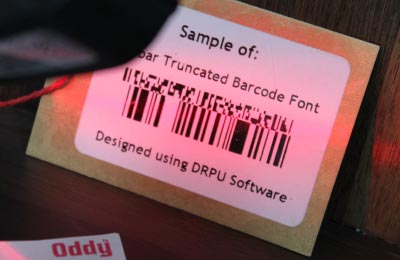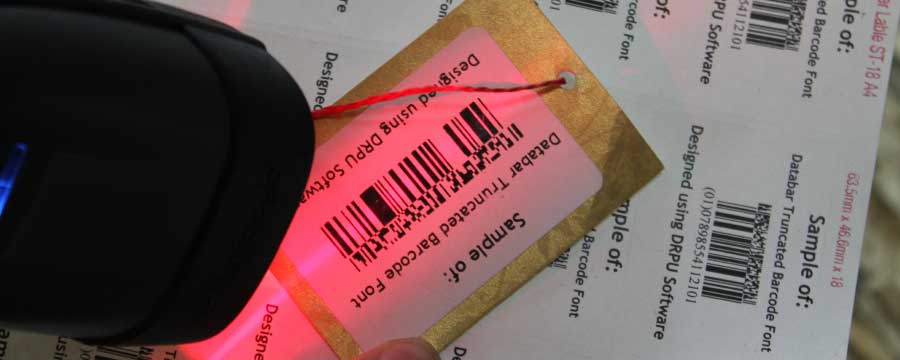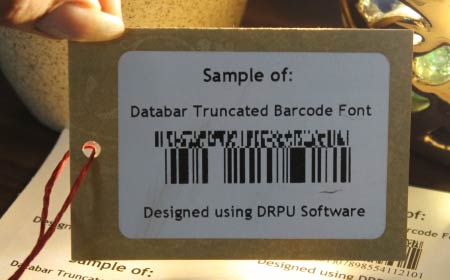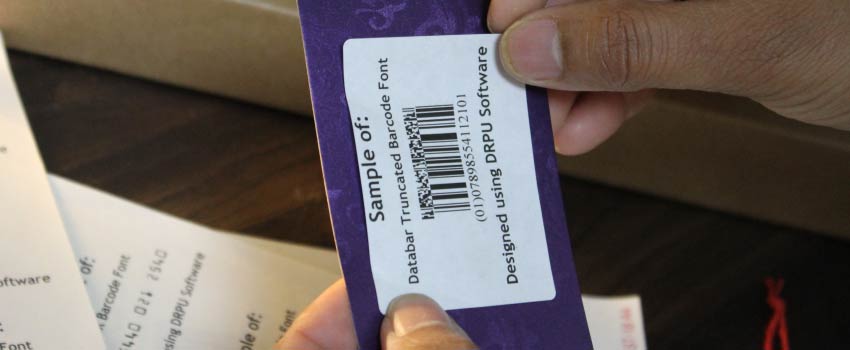Databar Truncated Barcode Read By Any Barcode Scanner
Databar Truncated Barcodes are a type of barcode that can be read by most modern barcode scanners. However, there are some factors that can affect the ability of a barcode scanner to read a Databar Truncated Barcode, such as the scanner's technology, its configuration, and the quality of the barcode itself.

➜ Barcode scanners use a variety of technologies to read barcodes, including laser scanners, linear imagers, 2D imagers, and camera-based scanners. Each technology has its own strengths and weaknesses when it comes to reading different types of barcodes.
➜ Laser scanners use a laser beam to read barcodes by reflecting the beam off the barcode's surface. Laser scanners are best suited for reading 1D barcodes, such as UPC and EAN codes, but may not be as effective at reading 2D barcodes, such as QR codes and Databar Truncated Barcodes.
➜ 2D imagers use a camera to capture an image of the barcode and then decode the barcode's data. 2D imagers are designed to read 2D barcodes, including Databar Truncated Barcodes, as well as 1D barcodes.Camera-based scanners use a high-resolution camera to capture an image of the barcode and then decode the barcode's data. Camera-based scanners are also designed to read 2D barcodes, including Databar Truncated Barcodes.
Barcode Scanner Configuration➜ The configuration of the barcode scanner can also affect its ability to read a Databar Truncated Barcode. Some barcode scanners are configurable and can be programmed to read different types of barcodes. In other cases, the scanner may be set up to read only specific types of barcodes, and may not be able to read a Databar Truncated Barcode without additional configuration.
Barcode Quality➜ The quality of the barcode itself can also affect the ability of a barcode scanner to read a Databar Truncated Barcode. If the barcode is smudged, scratched, or otherwise damaged, it may be more difficult for the scanner to read the barcode's data. In some cases, poor print quality or inadequate contrast between the barcode and its background can also make it more difficult for a scanner to read the barcode.
Conclusion In general, most modern barcode scanners should be able to read Databar Truncated Barcodes without difficulty. However, the ability of the scanner to read the barcode may be affected by a variety of factors, including the scanner's technology, its configuration, and the quality of the barcode itself. To ensure the best possible results, it is important to select a barcode scanner that is designed to read Databar Truncated Barcodes and to properly configure the scanner and ensure that the barcode is printed clearly and with adequate contrast.
Decode a Databar Truncated Barcode
Decoding a Databar Truncated Barcode requires the use of a barcode scanner or other scanning device. In this answer, we will discuss the process of decoding a Databar Truncated Barcode and the information that can be obtained from the barcode.

The Databar Truncated barcode is based on the GS1 DataBar symbology, which was developed by GS1, a global standards organization that specializes in supply chain management. The GS1 DataBar symbology is a family of barcodes that includes several different variations, each with its own specific use case.
| Scan the Barcode | To decode a Databar Truncated Barcode, the first step is to use a barcode scanner to scan the barcode. The scanner will emit a beam of light that reflects off the barcode, and the scanner will detect the reflection and convert it into a digital signal. |
| Convert the Digital Signal | The digital signal generated by the scanner needs to be converted into a format that can be read by a computer or other device. This is typically done using software that is designed to interpret the signal and convert it into a readable format. |
| Interpret the Barcode Data | Once the digital signal has been converted into a readable format, the barcode data can be interpreted. The information encoded in a Databar Truncated Barcode includes the item's Global Trade Item Number (GTIN), lot number, expiration date, and other important information. |
| Verify the Data | Before using the information obtained from the barcode, it is important to verify that the data is accurate and up-to-date. This can be done by checking the expiration date, lot number, and other information against the manufacturer's records. |
| Use the Data | Once the barcode data has been decoded and verified, it can be used for a variety of purposes, including tracking inventory levels, managing product recalls, and processing transactions. |
The DataBar Truncated barcode is called "truncated" because it omits the check digit and the packaging level indicator that are present in the full GTIN-14 barcode. This results in a shorter barcode that takes up less space on a product label or packaging. The DataBar Truncated barcode is typically used on small or irregularly shaped products, such as fresh produce or pharmaceuticals, where there is limited space available for labeling. It can also be used on products that are too small to accommodate a full GTIN-14 barcode, such as single-dose medications or small food items.
Overall, decoding a Databar Truncated Barcode is a simple process that can be done using a barcode scanner and software designed to interpret the barcode data. By decoding and verifying the barcode data, businesses can improve the efficiency and accuracy of their operations and ensure the safety and quality of their products.
Limitations of Using Databar Truncated Barcodes System

While Databar Truncated Barcodes offer several advantages over other types of barcodes, there are also some limitations to consider. In this response, we will explore these limitations in more detail.
🞛 Limited Scan DistanceOne of the limitations of Databar Truncated Barcodes is their limited scan distance. Due to their small size, Databar Truncated Barcodes may not be readable from a long distance, which can make them less suitable for applications where the barcode needs to be scanned from a distance. For example, in a retail environment, a barcode on a large product may need to be scanned from several feet away, which may not be possible with a Databar Truncated Barcode.
🞛 Limited Compatibility with Older SystemsAnother limitation of Databar Truncated Barcodes is their limited compatibility with older barcode scanning systems. While most modern barcode scanners can read Databar Truncated Barcodes, older systems may not be able to recognize this type of barcode. This can be a concern in industries where legacy systems are still in use, such as in some manufacturing environments.
🞛 Limited Data CapacityWhile Databar Truncated Barcodes offer a large data capacity compared to some other types of barcodes, they may not be suitable for applications where a very large amount of data needs to be encoded. For example, in some industries such as automotive or aerospace, it may be necessary to encode large amounts of data such as part numbers, serial numbers, and manufacturing data. In these cases, a Databar Truncated Barcode may not offer sufficient data capacity to meet the needs of the application.
🞛 Limited Support for Non-Standard CharactersDatabar Truncated Barcodes are designed to support a limited set of characters, which may not include all of the characters required for some applications. For example, in industries where foreign languages are commonly used, it may be necessary to encode characters such as accented letters or non-Latin characters. In these cases, a Databar Truncated Barcode may not be suitable, and other types of barcodes that support a broader range of characters may be required.
📋 Note: Overall, while Databar Truncated Barcodes offer several advantages, it is important to consider the limitations of this type of barcode before deciding whether it is the best choice for a particular application. Factors such as scan distance, compatibility with existing systems, data capacity, and support for non-standard characters should be carefully evaluated to ensure that the chosen barcode meets the needs of the application.
Advantages Of Using Databar Truncated Barcode System
Databar Truncated Barcodes offer several advantages over other types of barcodes, including their compact size, their ability to encode a large amount of data, and their suitability for use in a wide range of applications. In this response, we will explore these advantages in more detail.
- 01
Improved
Traceability
Databar Truncated Barcodes can also help to improve product tracking and traceability. By encoding detailed information about a product, such as its batch number, expiration date, and serial number, Databar Truncated Barcodes can help manufacturers and retailers to track products through the supply chain and ensure that they are being handled and stored appropriately. This can be particularly important in industries such as healthcare, where accurate regulatory compliance.
- 02
Large Data Capacity
Another advantage of Databar Truncated Barcodes is their ability to encode a large amount of data in a relatively small space. Databar Truncated Barcodes can encode up to 14 digits of numeric data or 13 alphanumeric characters, making them ideal for use in applications where a significant amount of data needs to be encoded in a small barcode. For example, Databar Truncated Barcodes are often used in the healthcare industry to encode patient information, and other medical records.
- 03
Compatibility Systems
Databar Truncated Barcodes are also highly compatible with existing barcode scanning systems, which makes them easy to integrate into existing workflows and processes. Because Databar Truncated Barcodes are based on the GS1 DataBar standard, which is widely used in different industries such as healthcare, retail, and logistics, they can be read by most modern barcode scanners without any special configuration or setup..
- 04
Compact Size
One of the key advantages of Databar Truncated Barcodes is their compact size. Unlike some other types of barcodes, which can be quite large and take up a significant amount of space on a product or document, Databar Truncated Barcodes are relatively small and can be printed in a compact space. This makes them ideal for use in situations where space is at a premium, such as on small items or in crowded retail environments.
- 05
Enhanced Inventory system
Databar Truncated Barcodes can also help to streamline inventory management processes. By encoding information about product quantities, location, and other key inventory data, Databar Truncated Barcodes can help retailers and warehouse managers to quickly and accurately track inventory levels and replenish stock as needed. This can help to reduce the risk of stockouts, overstocking, and other inventory-related issues that can impact business operations and profitability.
Overall, Databar Truncated Barcodes offer a number of advantages over other types of barcodes, including their compact size, large data capacity, compatibility with existing systems, improved product tracking and traceability, and enhanced inventory management capabilities. These benefits make them an attractive option for a wide range of applications across industries such as healthcare, retail, and logistics.
In addition to the GTIN-14 product identifier, the DataBar Truncated barcode can also encode other information, such as lot or batch numbers, expiration dates, and serial numbers. This information can be used to track inventory and prevent the distribution of expired or recalled products.
Industries Commonly Use Databar Truncated Barcodes
Databar Truncated Barcodes are used in a wide range of industries to track and manage products throughout the supply chain. In this answer, we will discuss some of the industries that commonly use Databar Truncated Barcodes and the benefits that these barcodes provide to each industry.

In this article, we will discuss the international use of MSI Plessey barcode and the factors that affect its adoption.
-
⮊ Retail
The retail industry is one of the primary users of Databar Truncated Barcodes. These barcodes are used to track inventory levels, facilitate checkout and sales, and manage product recalls. By using Databar Truncated Barcodes, retailers can efficiently track their inventory levels and quickly restock products that are running low.
Databar Truncated Barcodes also facilitate efficient checkout and sales. Retailers can use barcode scanners to quickly scan products and process transactions, reducing wait times for customers and improving the overall customer experience.
Finally, Databar Truncated Barcodes are used to manage product recalls. In the event that a product is found to be defective or unsafe, retailers can use the information encoded in the barcode to quickly identify affected products and remove them from store shelves.
-
⮊Pharmaceuticals
The pharmaceutical industry is another major user of Databar Truncated Barcodes. These barcodes are used to track the movement of drugs throughout the supply chain, from manufacturers to distributors to pharmacies.
By using Databar Truncated Barcodes, pharmaceutical companies can ensure that drugs are properly labeled and tracked, reducing the risk of errors and improving patient safety. Barcodes can also be used to track lot and batch numbers, expiration dates, and other important information, making it easier to identify and address issues with specific batches of drugs.
-
⮊Food
and Beverage
The food and beverage industry is another major user of Databar Truncated Barcodes. These barcodes are used to track the movement of food products throughout the supply chain, from farms and manufacturers to distribution centers and retail stores.
By using Databar Truncated Barcodes, food and beverage companies can ensure that their products are properly labeled and tracked, reducing the risk of contamination and ensuring that products are consumed before they expire. Barcodes can also be used to track lot and batch numbers, making it easier to identify and address issues with specific batches of food products.
-
⮊Logistics and Transportation
The logistics and transportation industry is another major user of Databar Truncated Barcodes. These barcodes are used to track the movement of products and shipments throughout the supply chain, from manufacturers to distributors to retail stores.
By using Databar Truncated Barcodes, logistics and transportation companies can ensure that products are properly labeled and tracked, reducing the risk of errors and improving the overall efficiency of the supply chain. Barcodes can also be used to track shipping containers and pallets, making it easier to manage inventory levels and track shipments as they move from one location to another.
Overall, Databar Truncated Barcodes are used in a wide range of industries to track and manage products throughout the supply chain. By using these barcodes, businesses can improve the efficiency and accuracy of their operations and ensure the safety and quality of their products. DataBar Truncated barcode is a versatile and powerful tool for inventory management and tracking in a wide range of industries. Its compact size and high level of information density make it ideal for use in situations where space is limited or a high level of data accuracy is required.
Another advantage of the DataBar Truncated barcode is its ease of scanning. Because it uses a 2D symbology, it can be scanned from any angle, making it faster and more reliable than traditional linear barcodes. It can also be read using a wide range of barcode scanners, including handheld scanners, stationary scanners, and mobile devices.